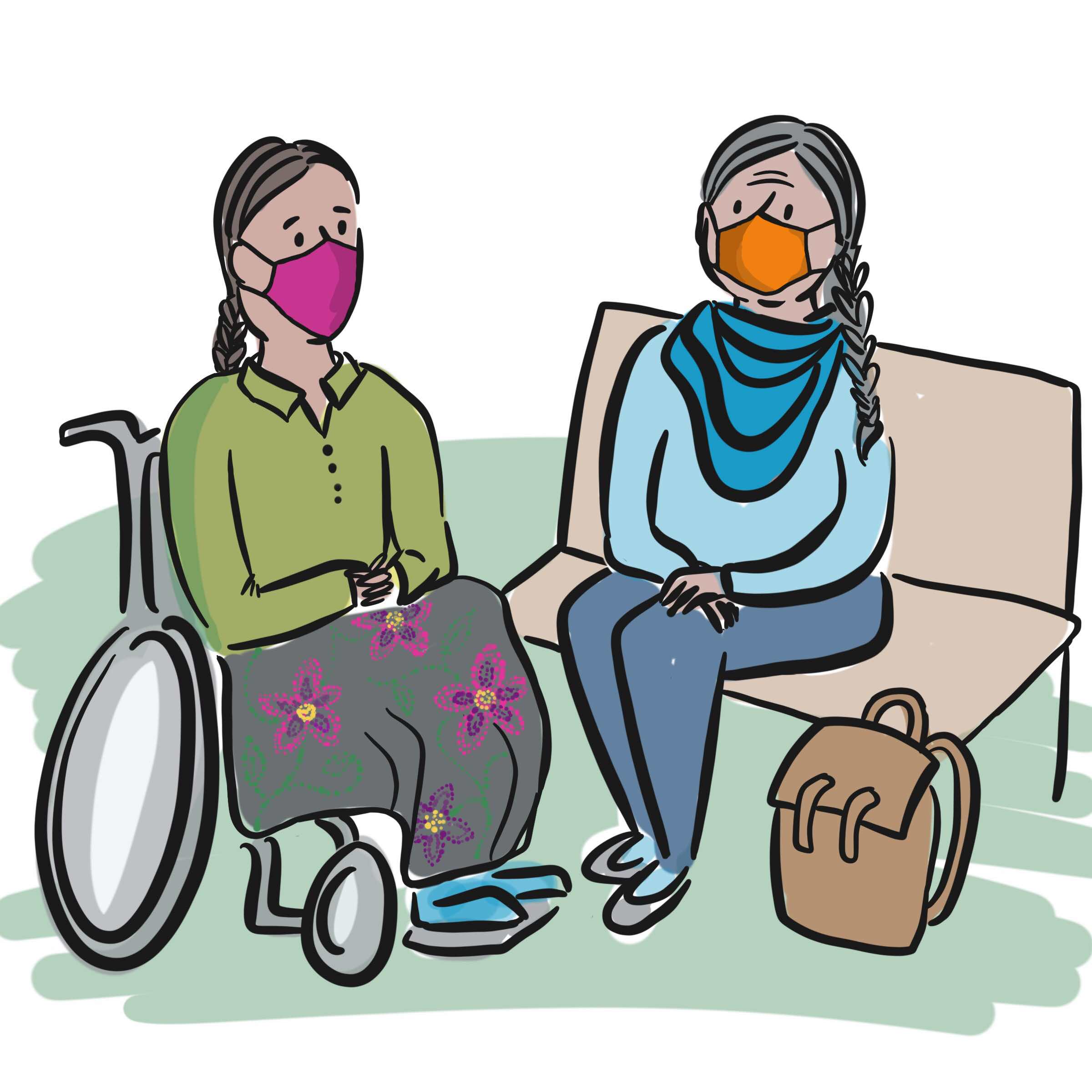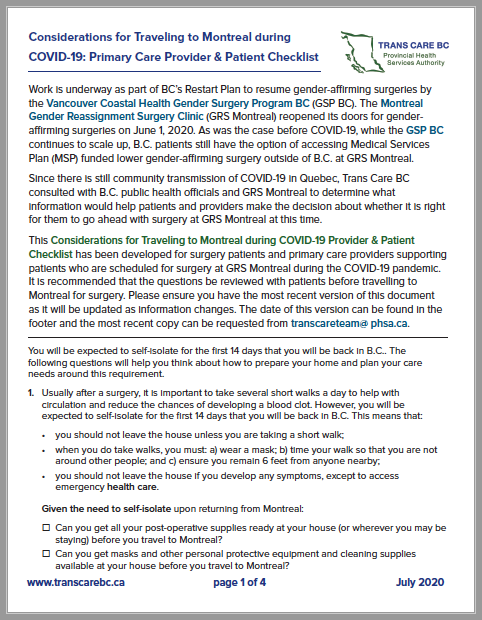Home Page
- This Guide
- Procedures
- COVID-19
This Guide
Gender-affirming phalloplasty, metoidioplasty, and erectile tissue (clitoral) release surgeries are publicly funded for Two-Spirit, transgender, and gender diverse individuals in British Columbia. These surgeries can be done at the Gender Surgery BC at Vancouver General Hospital.
This guide outlines the steps for accessing publicly funded phalloplasty, metoidioplasty, and erectile tissue (clitoral) release.
The additional procedures (i.e. urethral lengthening, vaginectomy, scrotoplasty, insertion of testicular and/or penile implants) may be included depending on a person’s goals and body. The insertion of implants takes place after one has finished healing from the initial surgery, which is usually a minimum of six months later.
Trans Care BC’s Health Navigation team is available to help you at any point in this process.
Explore this guide
To explore this guide, click through the categories listed above.
To use the menu feature, click on the green bar located on the left side of the page (computers), or at the top of the page (mobile devices).
Contact us
Trans Care BC’s Health Navigation Team is available to help you at any point in this process. You can find a link to our contact page in the bottom right corner of this guide.
Workbook for Phalloplasty, Metoidioplasty, and Erectile Tissue Release Surgery in BC
Preparing for lower surgery is a physical, emotional, mental and spiritual process. We’ve created the Workbook for Phalloplasty, Metoidioplasty, and Erectile Tissue Release Surgery in BC to help you along the way. It contains some of the information on this website, along with worksheets, checklists, and exercises.
Procedures
Click on a box below to learn more about the subject.
Erectile Tissue Release & Metoidioplasty
Procedures
Surgical techniques vary from surgeon to surgeon. This is the procedure common at GRS Montreal:
Some people choose to have erectile tissue release surgery without any additional procedures, while others may choose to have it in combination with additional procedures.
Erectile tissue release:
Surgical techniques vary from surgeon to surgeon. Before surgery, testosterone is taken to enlarge the erectile tissue (clitoris). Some people choose to wait 2-3 years to achieve maximum growth before proceeding with surgery.
The ligaments holding the erectile tissue (clitoris) in place under the pubic bone are cut, allowing the shaft to fall away form the body, giving it a more pronounced appearance
Fat may be removed from the pubis and skin may be pulled upward to bring your phallus forward.
Urethral lengthening:
Re-routing the urethra up through the tip of the penis, with the goal of allowing urinating from a standing position.
Lengthening may be done using nearby tissue (ie: inner labia) or buccal (cheek) tissue, depending on the individual.
Scrotoplasty:
The external genitals (labia or outer labia) may be shaped into a scrotum.
Vaginectomy
Removal of internal genital (vaginal) tissue and closing of genital opening (vaginal canal).
Implants
Testicular implants may be placed inside the scrotum at a later stage, usually a minimum of six months after the initial surgery.
Complications
All surgical procedures involve some risks. Risks include negative reactions to anesthesia, blood loss, blood clots and infection. These complications can, in extreme cases, result in death. It’s important to discuss these risks in detail with your surgeon. Your surgical care team will take a wide variety of steps to prevent these problems, detect them if they arise and respond to them appropriately. They will also inform you about what you can do to minimize your risks. Some complications are particularly associated with metoidioplasty.
Below are a list of some possible complications of this surgery. Please note – this list is not comprehensive and you should have a detailed discussion of risks with your surgeon.
Abscess formation
An abscess is a collection of pus caused by a bacterial infection. It can be treated with antibiotics or drained by the surgeon.
Decreased sensation
The risk of decreased sensation after metoidioplasty is less than with phalloplasty, but changes to sensation are still possible.
Dissatisfaction…
Some people may be dissatisfied with the size or shape of the penis. You can check with your surgeon to see if surgical revision is possible.
Hematoma
When blood collects in the surgical site, causing pain, swelling and redness. It is the most common complication. Drains and compression bandages are used to prevent hematomas. Smaller hematomas can be sucked out, but larger ones require removal through surgery.
Seroma
When clear fluid accumulates in the surgical site. Small seromas may need to be aspirated, or sucked out, once or more by the surgeon. Big seromas may need to be removed through surgery.
Wound separation
The partial or complete opening of incisions along the sutures.
Scarring
You can take steps to prevent significant scarring by following your surgeon’s advice about getting rest, avoiding the sun and doing massage exercises. Severe scarring may require surgical revision.
Urological complications
Even with urethral lengthening, some people will not be able to urinate while standing. This can be because of the urine stream (it may spray or dribble), or because the penis does not extend far enough out from the body.
Other urological complications include fistulas (flow of urine to areas other than urethra opening), stenosis (narrowing of the urethra, causing difficulty urinating), strictures (scarring inside the urethra, causing difficulty urinating) and hair growth inside the urethra. If these problems don’t resolve on their own, they may require additional surgery.
Phalloplasty
Procedures
Surgical techniques vary from surgeon to surgeon.
Complications
All surgical procedures involve some risks. Risks include negative reactions to anesthesia, blood loss, blood clots and infection. These complications can, in extreme cases, result in death. It’s important to discuss these risks in detail with your surgeon. Your surgical care team will take a wide variety of steps to prevent these problems, detect them if they arise and respond to them appropriately. They will also inform you about what you can do to minimize your risks.
Some complications are particularly associated with phalloplasty. Below are a list of some possible complications of this surgery. Please note – this list is not comprehensive and you should have a detailed discussion of risks with your surgeon.
Abscess formation
An abscess is a collection of pus caused by a bacterial infection. It can be treated with antibiotics or drained by the surgeon.
Decreased sensation or ability to achieve orgasm
There is risk of decreased sensation or inability to achieve orgasm after surgery.
Dissatisfaction with size or shape
Some people may be dissatisfied with the size or shape of the erectile tissue (penis). You can check with your surgeon to see if surgical revision is possible.
Hematoma
When blood collects in the surgical site, causing pain, swelling and redness. It is the most common complication. Drains and compression bandages are used to prevent hematomas. Smaller hematomas can be sucked out, but larger ones require removal through surgery.
Implant complications
Complications associated with penile implants include poor positioning, technical failure and infection. The implant can be either be repaired or surgically removed and replaced. Complications associated with testicular implants include poor positioning and infection.
Numbness in the hand or wrist of the donor arm
Usually resolves in a few weeks. Permanent changes to sensation or function are very rare but possible. Some people require prolonged physiotherapy to recover.
Wound separation
The partial or complete opening of incisions along the sutures.
Scarring
You can take steps to prevent severe scarring by following your surgeon’s advice about avoiding sun and doing massage exercises. Severe scarring may require surgical revision.
Seroma
When clear fluid accumulates in the surgical site. Small seromas may need to be aspirated, or sucked out, once or more by the surgeon. Big seromas may need to be removed through surgery.
Tissue transfer complications
Related to the transfer of skin from your forearm to your groin. There is a small risk of a partial or complete loss of the penis if the transfer is unsuccessful.
Urological complications
Very common, though they often resolve with time. Examples include fistulas (flow of urine to areas other than urethra opening), stenosis(narrowing of the urethra, causing difficulty urinating), strictures (scarring inside the urethra, causing difficulty urinating) and hair growth inside the urethra. If these problems don’t resolve on their own, they may require additional surgery.
COVID-19
Planning for gender-affirming surgery during the COVID-19 pandemic
If you plan to have gender-affirming surgery during the COVID-19 pandemic, prepare with pandemic safety in mind. Take time to review the checklist that is right for your situation with your GP or NP and the people who will be supporting you after surgery.

Gender-affirming surgery in BC
Here are some things to consider if you are having gender-affirming surgery in BC, during the COVID-19 pandemic.
Gender-affirming surgery in Montreal
Here are some things to consider if you are travelling to Montreal for gender-affirming surgery, during the COVID-19 pandemic.


